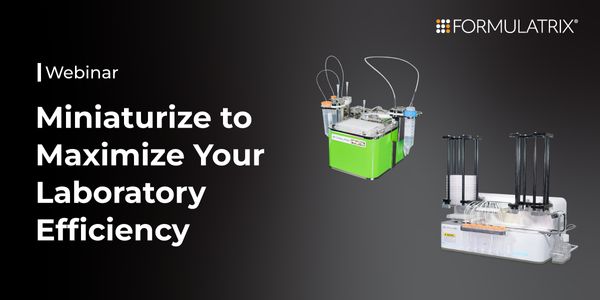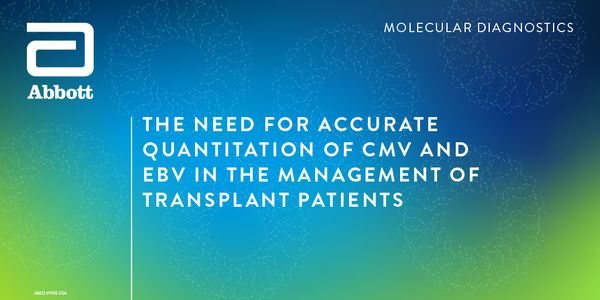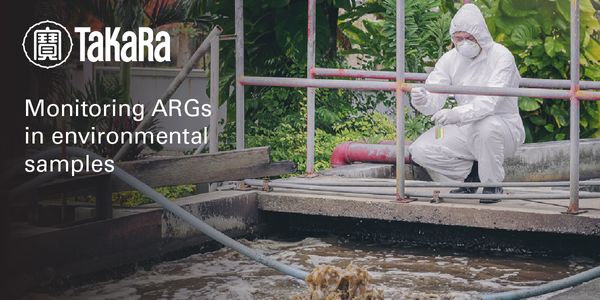PCR
PCR: Polymerase chain reaction, or PCR, is a laboratory technique used to make multiple copies of a segment of DNA. PCR is very precise and can be used to amplify, or copy, a specific DNA target from a mixture of DNA molecules.
-
APR 18, 2024 | 8:00 AMThis webinar will demonstrate how the MANTIS and TEMPEST liquid dispensers enable assay automation and miniaturization in various applications such as PCR, NGS, immunoassays, and cell and or...APR 18, 2024 | 7:00 AMAbstract: Beginning with a brief historical overview of CRISPR, we will trace its evolution to the current state of gene engineering, highlighting its pivotal role in reshaping the landscape...APR 02, 2024 | 8:00 AMCirculating tumor cells (CTCs) and circulating tumor DNA (ctDNA) have each gained attention as promising liquid biopsy markers, offering molecular insights into cancer progression, overall s...MAR 20, 2024 | 9:00 AMC.E. CREDITSJoin us in this enlightening session to deepen your understanding of qualifications and their transformative impact on risk management and regulatory adherence. Gain actionable insights that...Speaker: Danielle Wells, BS, MSPresented at: Guardians of Your Science, Ask the Expert Webinar Series
Sponsored By: Thermo Fisher ScientificOCT 30, 2023 | 8:00 PMDescription: Join this two-part webinar to learn how capillary electrophoresis (CE) complements sequencing technologies, such as next generation sequencing, that are being used by cancer res...OCT 26, 2023 | 8:00 AMDescription: Join this two-part webinar to learn when capillary electrophoresis is an ideal choice relative to other various sequencing technologies – such as next generation sequencin...SEP 28, 2023 | 10:00 AMAccurate diagnosis of H. pylori infection remains both crucial and challenging today. In line with current guidelines, confirming eradication after antibiotic treatment is essential. Diagnos...SEP 14, 2023 | 8:30 PMWastewater-based surveillance is valuable as it allows for the detection of pathogens before symptomatic cases are identified. In Korea, wastewater surveillance has been implemented, and the...SEP 14, 2023 | 11:00 AMC.E. CREDITSIn the United States, over 40,000 transplantations are performed annually. Ensuring post-transplant success requires diligent monitoring of infectious diseases that are associated with a wid...SEP 13, 2023 | 10:00 AMLiquid biopsy is an emerging area of clinical research, particularly in the context of cancer. As a minimally invasive complementary or alternative approach to tissue biopsies, liquid biopsi...Speaker: Dr. Eloisa Jantus Lewintre, PhD , Dr. Gorka Alkorta-Aranburu , Matteo Allegretti, PhDPresented at: The Future of Cutting-Edge Genomic Technologies for Liquid Biopsy Cancer Research
Sponsored By: Thermo Fisher ScientificSeptember 13 at 10:00am CEST, 9:00am BSTWebinar airing too early or too late for you? This webinar will also be available: September 13 at 10:00am PDT, 1:00pm EDT https://www.labroots.com/ms/webinar/dpcr-liquidbiopsy-panel-2 and S...Speaker: Dr. Eloisa Jantus Lewintre, PhD , Dr. Gorka Alkorta-Aranburu , Matteo Allegretti, PhDPresented at: The Future of Cutting-Edge Genomic Technologies for Liquid Biopsy Cancer Research
Sponsored By: Thermo Fisher ScientificSeptember 13 at 9:30am IST, 12:00pm CST/SGTLiquid biopsy is an emerging area of clinical research, particularly in the context of cancer. As a minimally invasive complementary or alternative approach to tissue biopsies, liquid biopsi...Speaker: Dr. Eloisa Jantus Lewintre, PhD , Dr. Gorka Alkorta-Aranburu , Matteo Allegretti, PhDPresented at: The Future of Cutting-Edge Genomic Technologies for Liquid Biopsy Cancer Research
Sponsored By: Thermo Fisher ScientificCurrently established rapid methods for sterility testing of advanced therapy medicinal products (ATMPs) are mostly based on growth-based processes or the detection......Speaker: Dr. Alexandra Mueller-Scholz , Yasmin Heynen
AUG 24, 2023 | 8:30 PM
C.E. CREDITS
When building your own infectious disease molecular panels there are many paths to consider. In this interview, we ask Marcus Cognetti and Dr. Ari Frenkel what approach is required to create...
AUG 08, 2023 | 8:00 AM
Antibiotic resistance is a global health threat and an emerging micropollutant of concern. Monitoring antibiotic resistance genes (ARGs) from environmental samples requires advanced molecula...
The use of adeno-associated viruses (AAV) as gene delivery vectors has vast potential for the treatment of many severe human diseases. A small group of intensively studied AAV capsids have b...
JUL 25, 2023 | 8:00 PM
C.E. CREDITS
NEED ABSTRACT Learning Objectives Understand how the challenges of amplification from low input DNA, including single cells, can be overcome Discover why more researchers are using a next ge...
JUL 11, 2023 | 12:00 AM
The human genome project was undertaken to determine the human DNA sequence and analyze variation among individuals. To make use of this information, tools were developed that could collect...
JUN 28, 2023 | 8:00 AM
C.E. CREDITS
Laboratories performing diagnostic testing for infectious diseases have an obligation to meet the needs of multiple patient populations. With infectious disease, time it takes for reporting...
JUN 22, 2023 | 11:00 AM
C.E. CREDITS
When building your own infectious disease molecular panels there are many paths to consider. In this interview, we ask Marcus Cognetti and Dr. Ari Frenkel what approach is required to create...
JUN 15, 2023 | 10:00 AM
C.E. CREDITS
Insights gained from studies using genome editing tools can provide a better understanding of cellular physiology, so that we can uncover answers to complex diseases and ultimately develop t...
JUN 14, 2023 | 8:00 AM
C.E. CREDITS
Insights gained from studies using genome editing tools can provide a better understanding of cellular physiology, so that we can uncover answers to complex diseases and ultimately develop t...
JUN 13, 2023 | 10:00 AM
Achieving consistent AAV quantification with the QuantStudio Absolute Q AutoRun dPCR Suite Accurate quantification of AAV vectors is crucial for quality control and timely decision-making du...
Speaker:
Kimberly Gomez
, Himani Patel
, Raquel Muñoz-Garcia, PhD
Sponsored By: Thermo Fisher Scientific
Real-time PCR, also known as quantitative PCR (qPCR), is the gold standard for sensitive, specific detection and quantification of nucleic acid targets. This qPCR technology as offered by Th...
APR 18, 2024 | 8:00 AM
This webinar will demonstrate how the MANTIS and TEMPEST liquid dispensers enable assay automation and miniaturization in various applications such as PCR, NGS, immunoassays, and cell and or...
APR 18, 2024 | 7:00 AM
Abstract: Beginning with a brief historical overview of CRISPR, we will trace its evolution to the current state of gene engineering, highlighting its pivotal role in reshaping the landscape...
APR 02, 2024 | 8:00 AM
Circulating tumor cells (CTCs) and circulating tumor DNA (ctDNA) have each gained attention as promising liquid biopsy markers, offering molecular insights into cancer progression, overall s...
MAR 20, 2024 | 9:00 AM
C.E. CREDITS
Join us in this enlightening session to deepen your understanding of qualifications and their transformative impact on risk management and regulatory adherence. Gain actionable insights that...
Speaker:
Danielle Wells, BS, MS
Presented at: Guardians of Your Science, Ask the Expert Webinar Series
Sponsored By: Thermo Fisher Scientific
Sponsored By: Thermo Fisher Scientific
OCT 30, 2023 | 8:00 PM
Description: Join this two-part webinar to learn how capillary electrophoresis (CE) complements sequencing technologies, such as next generation sequencing, that are being used by cancer res...
OCT 26, 2023 | 8:00 AM
Description: Join this two-part webinar to learn when capillary electrophoresis is an ideal choice relative to other various sequencing technologies – such as next generation sequencin...
SEP 28, 2023 | 10:00 AM
Accurate diagnosis of H. pylori infection remains both crucial and challenging today. In line with current guidelines, confirming eradication after antibiotic treatment is essential. Diagnos...
SEP 14, 2023 | 8:30 PM
Wastewater-based surveillance is valuable as it allows for the detection of pathogens before symptomatic cases are identified. In Korea, wastewater surveillance has been implemented, and the...
SEP 14, 2023 | 11:00 AM
C.E. CREDITS
In the United States, over 40,000 transplantations are performed annually. Ensuring post-transplant success requires diligent monitoring of infectious diseases that are associated with a wid...
SEP 13, 2023 | 10:00 AM
Liquid biopsy is an emerging area of clinical research, particularly in the context of cancer. As a minimally invasive complementary or alternative approach to tissue biopsies, liquid biopsi...
Speaker:
Dr. Eloisa Jantus Lewintre, PhD
, Dr. Gorka Alkorta-Aranburu
, Matteo Allegretti, PhD
Presented at: The Future of Cutting-Edge Genomic Technologies for Liquid Biopsy Cancer Research
Sponsored By: Thermo Fisher Scientific
Sponsored By: Thermo Fisher Scientific
September 13 at 10:00am CEST, 9:00am BST
Webinar airing too early or too late for you? This webinar will also be available: September 13 at 10:00am PDT, 1:00pm EDT https://www.labroots.com/ms/webinar/dpcr-liquidbiopsy-panel-2 and S...
Speaker:
Dr. Eloisa Jantus Lewintre, PhD
, Dr. Gorka Alkorta-Aranburu
, Matteo Allegretti, PhD
Presented at: The Future of Cutting-Edge Genomic Technologies for Liquid Biopsy Cancer Research
Sponsored By: Thermo Fisher Scientific
Sponsored By: Thermo Fisher Scientific
September 13 at 9:30am IST, 12:00pm CST/SGT
Liquid biopsy is an emerging area of clinical research, particularly in the context of cancer. As a minimally invasive complementary or alternative approach to tissue biopsies, liquid biopsi...
Speaker:
Dr. Eloisa Jantus Lewintre, PhD
, Dr. Gorka Alkorta-Aranburu
, Matteo Allegretti, PhD
Presented at: The Future of Cutting-Edge Genomic Technologies for Liquid Biopsy Cancer Research
Sponsored By: Thermo Fisher Scientific
Sponsored By: Thermo Fisher Scientific
Currently established rapid methods for sterility testing of advanced therapy medicinal products (ATMPs) are mostly based on growth-based processes or the detection......
Speaker:
Dr. Alexandra Mueller-Scholz
, Yasmin Heynen
AUG 24, 2023 | 8:30 PM
C.E. CREDITS
When building your own infectious disease molecular panels there are many paths to consider. In this interview, we ask Marcus Cognetti and Dr. Ari Frenkel what approach is required to create...
AUG 08, 2023 | 8:00 AM
Antibiotic resistance is a global health threat and an emerging micropollutant of concern. Monitoring antibiotic resistance genes (ARGs) from environmental samples requires advanced molecula...
The use of adeno-associated viruses (AAV) as gene delivery vectors has vast potential for the treatment of many severe human diseases. A small group of intensively studied AAV capsids have b...
JUL 25, 2023 | 8:00 PM
C.E. CREDITS
NEED ABSTRACT Learning Objectives Understand how the challenges of amplification from low input DNA, including single cells, can be overcome Discover why more researchers are using a next ge...
JUL 11, 2023 | 12:00 AM
The human genome project was undertaken to determine the human DNA sequence and analyze variation among individuals. To make use of this information, tools were developed that could collect...
JUN 28, 2023 | 8:00 AM
C.E. CREDITS
Laboratories performing diagnostic testing for infectious diseases have an obligation to meet the needs of multiple patient populations. With infectious disease, time it takes for reporting...
JUN 22, 2023 | 11:00 AM
C.E. CREDITS
When building your own infectious disease molecular panels there are many paths to consider. In this interview, we ask Marcus Cognetti and Dr. Ari Frenkel what approach is required to create...
JUN 15, 2023 | 10:00 AM
C.E. CREDITS
Insights gained from studies using genome editing tools can provide a better understanding of cellular physiology, so that we can uncover answers to complex diseases and ultimately develop t...
JUN 14, 2023 | 8:00 AM
C.E. CREDITS
Insights gained from studies using genome editing tools can provide a better understanding of cellular physiology, so that we can uncover answers to complex diseases and ultimately develop t...
JUN 13, 2023 | 10:00 AM
Achieving consistent AAV quantification with the QuantStudio Absolute Q AutoRun dPCR Suite Accurate quantification of AAV vectors is crucial for quality control and timely decision-making du...
Speaker:
Kimberly Gomez
, Himani Patel
, Raquel Muñoz-Garcia, PhD
Sponsored By: Thermo Fisher Scientific
Real-time PCR, also known as quantitative PCR (qPCR), is the gold standard for sensitive, specific detection and quantification of nucleic acid targets. This qPCR technology as offered by Th...






















